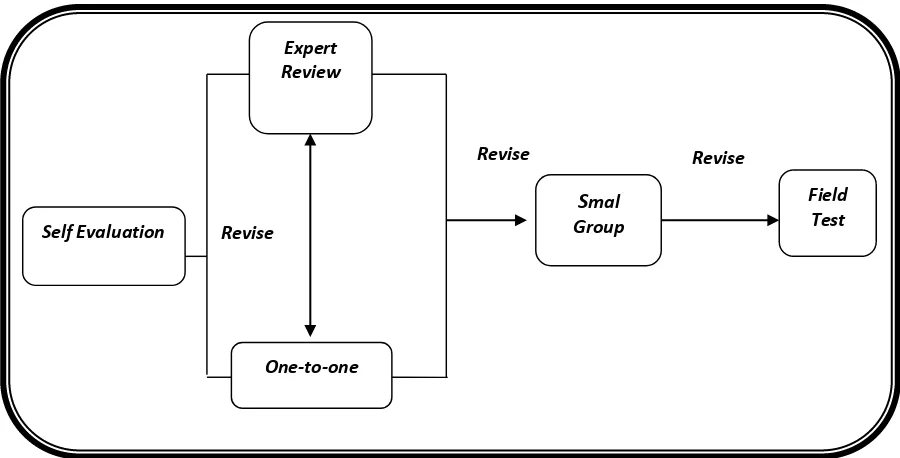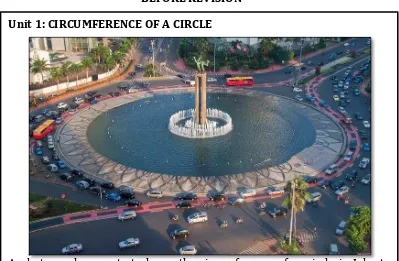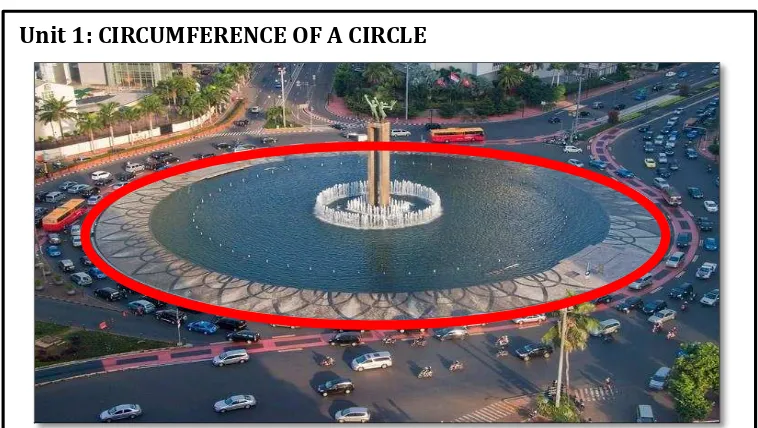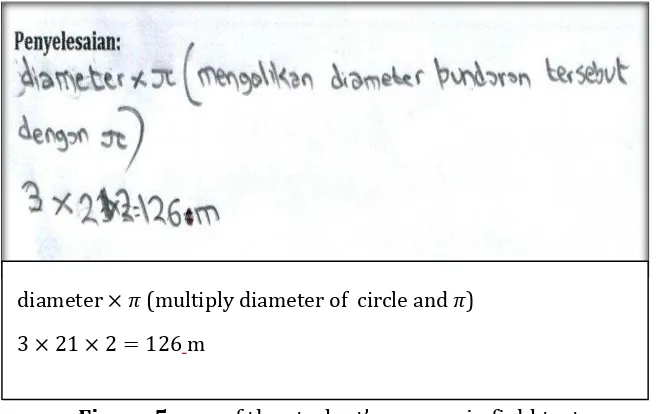DEVELOPING SIXTH LEVEL PISA PROBLEMS
IN LOWER SECONDARY SCHOOL: SPACE AND SHAPE
Tria Gustiningsi1, Ratu Ilma2, Somakim3
Sriwijaya University1,2,3
1) [email protected], 2) [email protected], 3) [email protected]
Abstract
According to Indonesian curriculum, some of the goals of learning mathematics are: students are able to (1) reason mathematically, (2) solve mathematics problem, (3) manipulate mathematically, (4) do analysis. But, based on the previous research and the rank of PISA, many weaknesses were traced when students did the mathematics problems in high level. This condition causes of students never practiced with the problem in high-level. To train students’ ability to do the high-level problems in mathematics, required the development of problems such as high-level. This study aims to develop sixth level PISA problems which valid and practical. The content of probems which developed is content space and shape . The researchers use design research using the type of development study to reach the objective of this study. This study consists of two stages, which are preliminary and prototyping (formative evaluation) stages. The preliminary stage, researchers conducted several activities that analyzing the students that will be the subject, analyzing curriculum, and analyzing the PISA problems which developed. The prototyping stage consists of self-evaluation, expert reviews, one-to-one experiments, small group experiment, and field test. The problems were tested to 28 seventh graders in SMPN 1 Palembang, Indonesia. The data were collected by test, interviews, and field notes. The result of this study is the sixth level PISA problems with content space and shape are valid and practical.
Keywords: problems of level six PISA, space and shape, valid, practical, development research, lower secondary school
INTRODUCTION
low of capability to solve non-routine or high level problems. Besides, the evaluation system in Indonesia still use the low-level problem so that student use formal knowledge in class (Stacey, 2010; Wu, 2011; Novita, Zulkardi, & Hartono, 2012; Kertayasa, 2014).
The sixth level is the highest level in PISA. There are a lot of skills that students should be used to resolve this problems. According to the principles of assessment in the PISA mathematics, essential skill needed in learning mathematics is the ability of mathematical literacy. Students are approved to have literacy ability if they are able to analyze, reason and communicate mathematical ideas and skills effectively. They are also needed to be able to solve and interpret non-routin or high level problems in mathematics. To train students’ ability to do the high-level problems in mathematics, required the development of problems such as high-level. Maharrani (2014) found that problems in the textbook lesson more procedures and are still in the low level. Therefore, the researchers develop problems of level six PISA. One of content in PISA is content space and shape . The research question is how to develop sixth level problems with content space and shape which valid and practical at lower secondary school?
THEORETICAL FRAMEWORK
Programme International Student Assessment (PISA)
According OECD (2013a), Programme International Student Assessment (PISA) is an international assessment organized by the countries who are members of the OECD (Organization for Economic Co-operation and Development). There are four mathematics content categories in PISA, which are: (1) Quantity, (2) Change and relationships, (3) Space and shape, and (4) Uncertainty and data. The present study, focuses solely in space and shape. This content is related to geometry lessons. Problems around space and shape asses studens’ ability to recognize shapes, look for similarities and differences in various dimensions and forms of representation. Besides, this content is related to identify the characteristics of an object in relation to the position of the object (OECD, 2013b). PISA has six levels. The following are six levels in PISA according OECD (2013).
Table 1. Proficiency scale descriptions for mathematics (2003-2009)
Level Description
6 Students can do the conceptualization, generalization and use information based on investigate and modeling of complex problem situations.
Students can link different information sources with flexible and translate it.
Students are able to think and reason mathematically.
Students can formulate and communicate with the right actions and reflect on taking into account its findings, interpretations, opinions, and accuracy in a real situation.
(OECD, 2013b)
METHOD
This study is a design research using the type of development study. There are 28 sevent graders in SMPN 1 Palembang participated in this study. This study consist of two stages, there are preliminary and prototyping (formative evaluations) stages. In thehe preliminary stage, researchers conducted several analysis. Those analysis include analyzing the students that will be the subject, analyzing curriculum, and analyzing the PISA problems which are developed. The prototyping stage consists of self-evaluation, expert reviews, one-to-one experiments, small group experiment, and field test (Tessmer, 1993). Below is the flow design of formative evaluation types.
Figure 1. The Flow Design of formative evaluation (Tessmer, 1993: 16)
The technique of data collection in this study are test to student by give the sixth level PISA problems, interview to student who become the subject of research, questionaire to find out students’ comments with respect to problems that was developed. The data analyzed from the student answer, then it accounted for valid and reliable.
RESULT AND DISCUSSION
In this part will discussed is the stage for development, which are preliminary and prototyping stage (formative evaluation).
Expert Review
One-to-one Revise
Revise
Smal Group
Field Test Revise
1. Preliminary
At this stage, researchers conducted several activities that analyzing the students that will be the subject, analyzing curriculum, and analyzing the PISA problems which developed. Besides, researchers designed the draft and produce a device prototype instrument.
2. Prototyping a. Self Evaluation
At this stage, the researchers evaluate its own draft that created and produced the first prototype. The following is one of the problems which developed by the researcher.
BEFORE REVISION
Figure 2. One of the problems which developed
b. Expert Review
The first prototype submitted to the expert for validation. In this case, the experts are:
1. Prof. Kaye Stacey, professor of mathematics education at the University of Melbourne, Australia. She is the chairman of the Mathematics Expert Group (MEG) Unit 1: CIRCUMFERENCE OF A CIRCLE
A photographer wants to know the circumference of a c ircle in Jakarta through pictures which he took.
Question 1:
2. Dr. Ross Turner, director of the Australian Council for Educational Research (ACER). He is the head of the experts team in PISA.
3. Kamaliyah, M.Pd., researcher who have been researching on the PISA.
4. Ahmad Wachidul Kohar, M.Pd., researcher who have been researching on the PISA.
c. One to One
The researchers carry out one to one test to five students. During the test, the researcher asked whether the problems can understood by students or not, other than that the students also fill out questionnaires to give comment and suggestion for the problems in terms of language, images, tables, and figures.
Table 2. The comment or suggestion in expert review and one to one stage
Validation Stage
Comment or suggestion
Expert review
Which circle do you mean? The red painted lane on the roadway? The curb next to the roadway? The central ornament? The pond? You need to ask a clearer question. I think it is probably formulate because there is a real world
problem, and the difficult thing will be to find the mathematics and data that can be used.
Give caption about Selamat Datang monument
One to one I don’t know which circle do you mean.
The first prototype not only validated qualitatively, but also quantitatively. The first prototype were tested to some students in class which are the different students to field test students. After that, the researcher carried out validity and reliability analysis of each items.
AFTER REVISION
Figure 3. The problem after revision d. Small Group
At this stage, researcher carries out the test for six students. After working with the problems, students fill out the questionnaire and researcher asks something about the test. The following one of the student’s answer.
Figure 4. One of the student’s answer in small group
Based on the student’s answer, the student said that the question is not complete. After interviewed, the student said that he could not do the problem because there is no number in that problem. Whereas, researchers did not provide a number on the problem
Unit 1: CIRCUMFERENCE OF A CIRCLE
Selamat Datang Monument is a monument located in the middle of the Hotel Indonesia, Jakarta, Indonesia.
Question 1:
Estimate the circumference of the circle and explain your strategy.
objects that are all around the circle. In this case, there is no something which revised in this problem so that this problem used to the third prototype.
e. Field Test
At this stage, the test given to students who are the subject of research. The results of the students' answers analyzed to know potential effects of problems that developed. The following one of student’s answer in the field test.
Figure 5. one ofthe student’s answer in field test
Based on the figure 5, the student writes a formula of circle circumference, after that he writes × × = 6 . Then, the researcher asks the student about what he wrote. The student assuming the length of one car is 3 meters, then the students count the number of cars for a half circle. In a half circle there are 21 cars, then to get the number of cars in one circle, he multiply 21 x 2, so that he writes circumference of a circle is " ×
× = 6 . Based on the answers, the students understand the concepts well and use the information to solve problems, students are also able to reason, but the students have not been able to communicate the answer in detail. Based on the indicators of level in PISA, this problem according to the indicator level 6.
CONCLUSION
The result in this study is sixth level pisa problems in lower secondary school with content space and shape are valid and practical. The prototype is valid qualitatively by experts, one to one experiment, and small group experiment. That prototype is valid quantitatively by tested to student and accounted for validity and reliability of each item. In field test, researcher give test to 28 student to knowing that the problems which developed can be used on the actual situation.
REFERENCES
Kertayasa, I. K. (2014). Achievement Of Indonesian Student In Assessment By Using Online Mathematical Problems. The Second South East Asia Design/Development Research 2014 (pp. 162 – 171). Palembang: Universitas Sriwijaya
diameter × � (multiply diameter of circle and �)
Maharani, Asri. (2007). Pengembangan Buku Pengayaan Pengetahuan Live with Protist sebagai Alternatif Sumber Belajar Biologi untuk Siswa SMA/MA [Development kit for live with protist as an alternative source for biology in senior high school]. Thesis. Yogyakarta: UIN Sunan Kalijaga.
NCTM. (2010, April 8). Why is Teaching with Problem Solving Important to Student Learning?. Problem Slving Research Brief, pp. 1-6
OECD. (2013a). PISA 2012 Assessment and Analytical Framework: Mathematics, Reading, Science, Problem Solving and Financial Literacy. Paris: OECD
OECD. (2013b). PISA 2015 Draft Mathematics Framework. Paris: OECD



